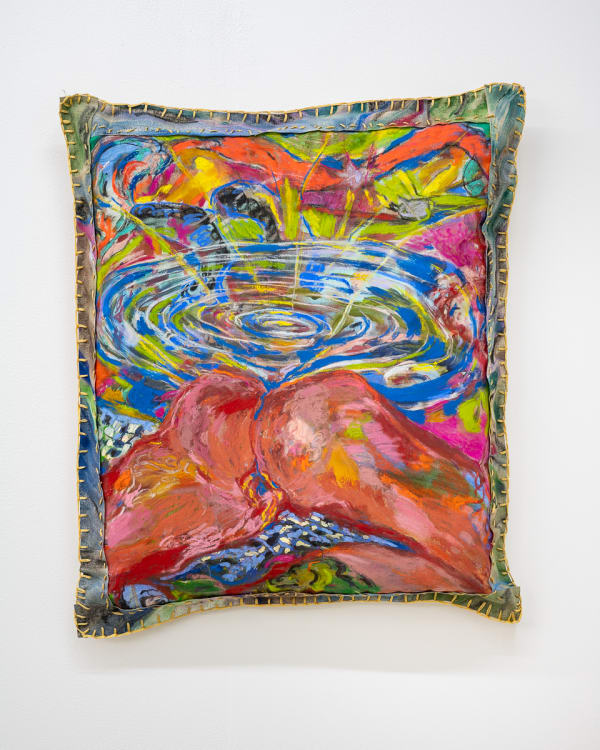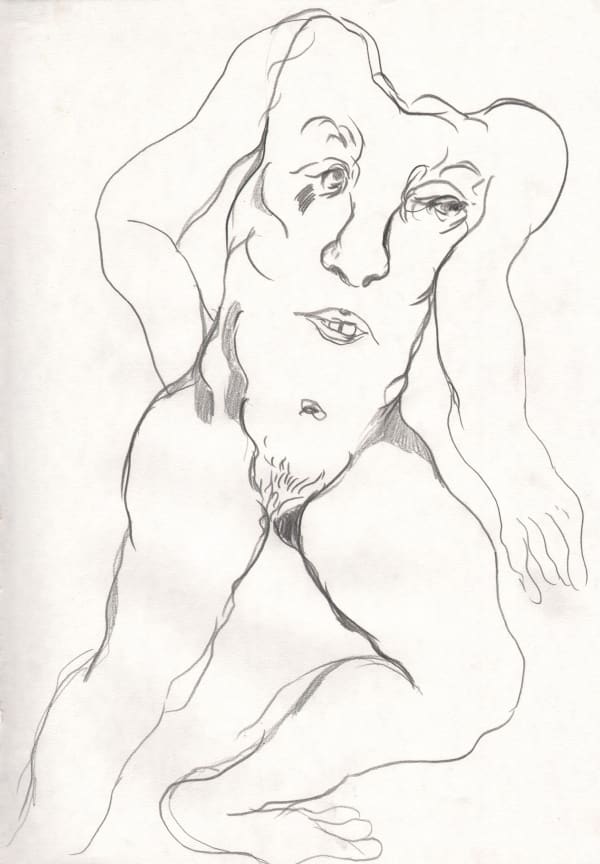-
Headless: Maya Weishof
Curated by Kiki Mazzuchelli -
-
Kupfer is pleased to present Brazilian painter Maya Weishof’s first UK exhibition in partnership with Galeria Millan in São Paulo.
Titled Headless, the show is the result of a two-month residency at Kupfer studios, and it brings together a new series of works that explore the architecture of the gallery to establish a dialogue between painting, set design, ornament, and space. At Kupfer, Weishof freely experimented with new possibilities of display, emphasising the scenographic qualities of the work to create a layered environment that invites viewer to move through and project their gaze beyond the paintings.
-

Maya Weshof, The Headless People, 2021
-

Maya Weishof, Untitled, 2021
-

-
In the space of almost two months, the artist’s studio was gradually taken over by a multitude of drawings, paintings, and reference images from old masters’ works ranging from Bosch, Uccello, and Brueghel, to works by relatively less popular figures like the Italian painter Carlo Crivelli, whose exquisite Madonna and Child (ca. 1480) is decorated with trompe l’ceil details and framed by cucumbers and apples that symbolise, respectively, redemption and sin. While some of the motifs that populate Weishof’s work are taken from historical sources, they are combined with images that spring from personal memories and everyday life. Importantly, her work deliberately avoids the moralising messages conveyed in most classical art; on the contrary, they seem to be a celebration of earthly delights that acknowledges heaven and hell as indistinct aspects of the one thing we can call ‘life’.
-
-
 Maya Weishof, Leave Behind, 2021
Maya Weishof, Leave Behind, 2021 -
 Maya Weishof, No Head, Big Talk, 2021
Maya Weishof, No Head, Big Talk, 2021 -
 Maya Weishof, Pillow Pum, 2021 Sold
Maya Weishof, Pillow Pum, 2021 Sold -
 Maya Weishof, The Headless People, 2021
Maya Weishof, The Headless People, 2021
-
 Maya Weishof, Window, 2021 Sold
Maya Weishof, Window, 2021 Sold -
 Maya Weishof, You in Somewhere, 2021 Sold
Maya Weishof, You in Somewhere, 2021 Sold -
 Maya Weishof, Untitled, 2021
Maya Weishof, Untitled, 2021 -
 Maya Weishof, Untitled, 2021
Maya Weishof, Untitled, 2021
-
 Maya Weishof, Untitled, 2021
Maya Weishof, Untitled, 2021 -
 Maya Weishof, Untitled, 2021
Maya Weishof, Untitled, 2021 -
 Maya Weishof, Untitled, 2021
Maya Weishof, Untitled, 2021 -
 Maya Weishof, Untitled, 2021
Maya Weishof, Untitled, 2021
-
 Maya Weishof, Untitled, 2021
Maya Weishof, Untitled, 2021 -
 Maya Weishof, Untitled, 2021
Maya Weishof, Untitled, 2021 -
 Maya Weishof, Untitled, 2021
Maya Weishof, Untitled, 2021 -
 Maya Weishof, Untitled, 2021
Maya Weishof, Untitled, 2021
-
 Maya Weishof, Untitled, 2021
Maya Weishof, Untitled, 2021 -
 Maya Weishof, Untitled, 2021
Maya Weishof, Untitled, 2021 -
 Maya Weishof, Untitled, 2021
Maya Weishof, Untitled, 2021 -
 Maya Weishof, Untitled, 2021
Maya Weishof, Untitled, 2021
-
 Maya Weishof, Untitled, 2021
Maya Weishof, Untitled, 2021 -
 Maya Weishof, Untitled, 2021
Maya Weishof, Untitled, 2021 -
 Maya Weishof, Untitled , 2021
Maya Weishof, Untitled , 2021 -
 Maya Weishof, Untitled, 2021
Maya Weishof, Untitled, 2021
-
-
About Maya Weishof
Maya Weishof (b.1993, Curitiba, Brazil) lives and works in São Paulo, Brazil. Weishof’s practice is interested in expanding figurative visual possibilities in painting. She conceives of images through fragments, distortions, caricatures and hybrid creatures, often revealing bodies and landscapes that begin and end in one another.
Weishof graduated with a BA in Visual Arts from Universidade Federal do Paraná (UFPR) in 2016. She was selected for the artist residency program of Zaratan Arte Contemporânea in Lisbon, Portugal, and also for the Novas Poéticas, program that included Visual Arts students from all over Brazil. In 2017, Weishof participated in a group of practical investigations in painting under the guidance of artists Regina Parra and Rodolpho Parigi in São Paulo and at the SESI Visual Arts Center, oriented by artist Ricardo Basbaum. In 2018, she participated in the exhibition project Confluências Poéticas at SESC Paço da Liberdade in Curitiba. In 2019, Weishof was selected for the artist residency program Pivô Arte e Pesquisa, in São Paulo. In the same year, she was invited by Cisterna Galeria in Lisbon to participate in the C-Lab artist residency program.

































